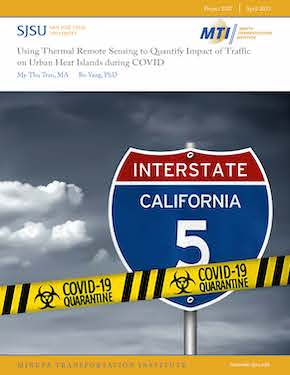- 408-924-7560
- mineta-institute@sjsu.edu
- Donate
Using Thermal Remote Sensing to Quantify Impact of Traffic on Urban Heat Islands during COVID
A three-month lockdown in the U.S. at the beginning of the COVID-19 outbreak in 2020 greatly reduced the traffic volume in many cities, especially large metropolitan areas such as the San Francisco Bay Area. This research explores the impact of transportation on climate change by using remote sensing technology and statistical analysis during the COVID-19 lockdown. Using thermal satellite data, this research measures the intensity of the urban heat island, the main driver for climate change during the urbanization process. The research team acquired morning and afternoon MODIS data in the same periods in 2019 before the pandemic and 2020 during the pandemic. MODIS imagery provides a wall-to-wall land surface temperature map to precisely measure the dynamics of the urban heat effect. In situ meteorological data were also acquired to build an urban surface energy budget and construct statistical models between solar radiation and the intensity of heat dynamics. The team implemented this urban heat budget in six counties in Northern California. This research quantifies the impact of lockdown policies on heat intensity in urban areas and human mobility in the context of COVID-19 and future pandemics. The quantitative results obtained in this study provide critical information for analyses of climate change impact on an urban scale.
MY-THU TRAN, MA
My-Thu Tran is a PhD student in the Geography Joint Doctoral Program offered by San Diego State University and the University of California, Santa Barbara. She has a B.A. in Geography Teacher Education from Vietnam, and an M.A. in Geography from San José State University. Her research interests include using GIS, Remote Sensing to study environmental problems, UAV/Drone Mapping, Social-Ecological Systems, Cartography, and Geovisualization.
BO YANG, PHD
Dr. Yang is an Assistant Professor in the Department of Urban & Regional Planning at San José State University and a Research Associate at the Mineta Transportation Institute. He has an interdisciplinary education background including a B.S. in Applied Mathematics, an M.S. in Computer Science, and Ph.D. in Geography. Dr. Yang’s research interests include GIS, remote sensing, spatial statistics, UAV/drone mapping for coastal science, urban heat effect, transportation impact on urban environment, and human-environment interaction. He has published about 40 papers in peer-reviewed journals such as Remote Sensing of Environment, International Journal of Geographical Information Science, and Geophysical Research Letters.
-
Contact Us
San José State University One Washington Square, San Jose, CA 95192 Phone: 408-924-7560 Email: mineta-institute@sjsu.edu






